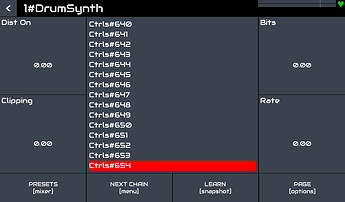Hello to all Zynthianists.
As I’ve been playing around with drum programs, I came across this note on GeonKick:
LV2 Plugin
There are two versions of the plugin: the default version and the “Single” version.
- The default plugin version supports kits with 16 instruments and creates 16 stereo audio output channels per plugin instance. One instance of this plugin will use approximately 35MB of heap memory.
- The “Single” plugin version does not support kits and only includes one instrument and one stereo audio output channel. One instance of this version will use about 2MB of heap memory. If only one instrument per track is needed, it is recommended to use the “Single” version of the plugin.
This applies to version 3.4.0.
Due to the fact that the classic GeonKick has 16 stereo outputs, which is simply not what Zynthian supports. So the new GeonKlick single allows you to play one sound on one stereo channel. Which is a way to avoid alternating left and right channels during round-robin.
After trying the installation in Windows and Linux, I thought that I would also try it in Zynthian and that in new image oram.
I’ve been following the recommendations on how to install Geonkick from their repository. I just excluded libjack-dev from apt-get. So it was as follows:
apt-get install build-essential cmake libsndfile-dev rapidjson-dev lv2-dev libcairo2-dev
git clone https://gitlab.com/Geonkick-Synthesizer/geonkick
mkdir geonkick/build
cd geonkick/build
cmake ../
make
make install
Surprisingly, everything worked.
I created a snapshot with seven instances of GeonKick, made a specific preset in each and saved it. In the mixer, I played with the settings of individual channels (volume and pan). And it works.
By the way, the assignment of the same midi channel for all instances of GeonKick is nice.
The only thing that doesn’t work is the display of available presets directly in the Zynthian UI, although I searched for them in webconf and even rebooted zynthian.
Here are the pictures and audio sample.
EDIT: and snapshot
013-geonkick-single.zss (9.9 KB)


